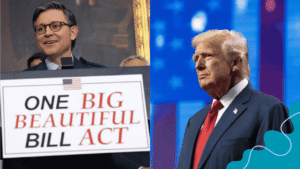On July 4, 2025, President Donald Trump put his signature on H.R. 1, officially named the One Big Beautiful Bill Act, a major piece of legislation that continues many tax cuts from the 2017 Tax Cuts and Jobs Act and makes changes to federal programs like Medicaid and food assistance. This bill, often just called OBBBA, came out of months of debate in Congress, where Republicans wanted to keep tax breaks for individuals and businesses, while Democrats raised concerns about cuts to programs that help millions of Americans.
The Congressional Budget Office and Joint Committee on Taxation say the bill will add about $3.4 trillion dollars to the federal deficit over the next ten years, and that number grows to over $4.1 trillion when interest on new borrowing is added.
Key Takeaways
- The One Big Beautiful Bill Act, signed into law on July 4, 2025, adds $3.4 trillion to the federal deficit over the next decade, with interest costs pushing the total past $4.1 trillion, making it one of the costliest laws in recent history.
- Permanent extensions of 2017 tax cuts, like lower income tax rates and a doubled Child Tax Credit, drive most of the bill’s cost, benefiting families and businesses but complicating the tax code.
- Spending cuts to Medicaid and SNAP offset $1.1 trillion of the bill’s tax cuts, but could leave millions without health coverage or food assistance, sparking debate over fairness.
- The bill’s long-term impact depends on future decisions to extend temporary tax breaks, which could raise costs to $5 trillion, and on how businesses and individuals adapt to the changes.
Table of Contents
Key Financial Impacts of the One Big Beautiful Bill Act (2025–2034)
The following table summarizes the major financial impacts of the One Big Beautiful Bill Act (OBBBA), as estimated by the Congressional Budget Office (CBO) and Joint Committee on Taxation (JCT). It includes the 10-year deficit impact of key tax and spending provisions, along with the interest cost, to provide a clear picture of the bill’s fiscal effects.
Category | Provision | 10-Year Deficit Impact (Billions) | Notes |
Major TCJA Extensions | Lower individual income tax rates | +$2,200 | Benefits high earners most; permanent extension. |
Doubled standard deduction | +$1,400 | Increases take-home pay for families. | |
Alternative minimum tax relief | +$1,400 | Shields wealthier taxpayers. | |
Doubled Child Tax Credit | +$881 | Now $2,200 per child; helps families. | |
20% pass-through deduction | +$737 | Supports small businesses; permanent. | |
State and local tax (SALT) deduction cap | -$946 | Limits deductions in high-tax states. | |
Repeal of personal exemptions | -$1,900 | Offsets taxpayer relief. | |
Subtotal (TCJA Extensions) | +$3,772 | Accounts for 110% of net cost. | |
Other Tax Provisions | Full expensing for equipment/R&D and business interest deductions | +$646 | Encourages business investment. |
No tax on tips, overtime, auto loan interest, senior deduction | +$245 | Temporary; expires after 2028. | |
Estate tax relief | +$212 | Benefits high-net-worth estates. | |
Premium tax credit restrictions | -$185 | Tightens health insurance subsidies. | |
Inflation Reduction Act clean energy rollbacks | -$543 | Reduces green energy incentives. | |
Other tax cuts and revenue pay-fors | +$432 | Miscellaneous provisions. | |
Subtotal (Other Tax Provisions) | +$807 | Adds complexity to tax code. | |
Spending Provisions | Immigration enforcement and border security | +$175 | Funds border walls, detention centers. |
Military spending | +$150 | Supports troop housing, training. | |
SNAP reforms | -$187 | Tightens eligibility; affects food assistance. | |
Student loan reforms | -$320 | Adjusts repayment terms. | |
Medicaid reforms | -$917 | Could leave 11.8 million uninsured by 2034. | |
Other spending changes | +$8 | Minor adjustments. | |
Subtotal (Spending Provisions) | -$1,091 | Offsets 25% of tax cuts. | |
Interest on New Debt | Additional interest costs | +$700 | Due to increased borrowing. |
Total Net Deficit Impact | +$4,188 | Includes interest; $3.4 trillion without. |
A $3.4 Trillion Bill, and Then Some
The One Big Beautiful Bill Act is no small change. According to the CBO and JCT, nonpartisan scorekeepers for Congress, the law will increase federal deficits by $3.4 trillion from 2025 to 2034. Add in the interest on new borrowing, and the total cost climbs to over $4.1 trillion. That’s a bigger price tag than any law since the 2012 American Taxpayer Relief Act, which made Bush-era tax cuts permanent at a cost of $4 trillion.
Supporters, including the White House, argue the bill fuels economic growth that could shrink deficits over time. Critics, though, point to posts on X warning of a debt explosion, with one estimate pegging the impact at $4.1 trillion. Either way, the numbers are staggering, and they raise questions about how we’ll pay for it all.
Costs That Pile Up Early
Not all of that $3.4 trillion hits at once. More than 60% of the cost lands in the first five years, from 2025 to 2029. Why? Many of the bill’s tax cuts, like deductions for tips and overtime, are temporary and expire by 2028 or 2029.
Meanwhile, some spending cuts, like those to Medicaid, kick in later. If future lawmakers extend those tax breaks without new savings, the Bipartisan Policy Center estimates an extra $800 billion in costs, pushing the total to $5 trillion with interest.
That’s a lot to ask of a nation already grappling with a growing debt. It’s like signing up for a big loan and hoping you’ll get a raise to cover it.
The Tax Cuts Driving the Deficit
The heart of OBBBA is its tax provisions, especially making permanent the 2017 Tax Cuts and Jobs Act policies that were set to expire. Seven major TCJA extensions account for $3.7 trillion of the deficit impact, more than the bill’s net cost.
Here’s the breakdown:
- Lower individual income tax rates: Keeping these rates costs $2.2 trillion, giving relief to millions but especially benefiting higher earners.
- Doubled standard deduction: At $1.4 trillion, this boosts take-home pay for families, like our Ohio baker, but adds to the deficit.
- Alternative minimum tax relief: Another $1.4 trillion, shielding wealthier taxpayers from extra taxes.
- Doubled Child Tax Credit: Now $2,200 per child, this costs $881 billion and helps families like that Texas parent.
- 20% pass-through deduction: Worth $737 billion, it supports small businesses but complicates the tax code.
- State and local tax (SALT) deduction cap: Raising the cap to $40,000 saves $946 billion by limiting deductions for high-tax states.
- Repeal of personal exemptions: This saves $1.9 trillion but offsets some of the taxpayer relief.
These changes lock in tax breaks for many, but they don’t simplify things. The tax code’s getting trickier, and that’s a headache for folks filing their returns.
New Tax Breaks and Trade-Offs
Beyond the TCJA extensions, OBBBA adds new tax provisions that tack on $807 billion to the deficit. Some highlights:
- Full expensing for equipment and R&D: Costing $646 billion, this lets businesses write off investments right away, spurring growth but adding to the debt.
- No tax on tips, overtime, and auto loan interest, plus senior deduction: These temporary breaks, worth $245 billion, help servers, factory workers, and seniors, but phase out after 2028.
- Estate tax relief: At $212 billion, this eases taxes for wealthy estates, a win for high-net-worth families.
- Premium tax credit restrictions: Saving $185 billion, this tightens eligibility for health insurance subsidies.
- Clean energy rollbacks: Cutting $543 billion in Inflation Reduction Act credits, this scales back green energy incentives, a move critics say hurts climate efforts.
For that server relying on tips or a retiree on a fixed income, these breaks could mean extra cash. But rolling back clean energy credits might slow down projects in places like rural Republican districts, where solar and wind were booming. It’s a mixed bag, and not everyone’s happy about it.
Spending Shifts: Savings and Sacrifices
To offset the $4.5 trillion in net tax cuts, OBBBA includes $1.1 trillion in spending changes. Some add costs, others cut them:
- Immigration enforcement and border security: $175 billion boosts funding for border walls and detention centers.
- Military spending: $150 billion goes to defense, including troop housing and training.
- SNAP reforms: Saving $187 billion, these changes tighten eligibility, potentially affecting millions on food assistance.
- Student loan reforms: Saving $320 billion, these adjust repayment terms, impacting borrowers.
- Medicaid reforms: The biggest saver at $917 billion, these reforms could leave 11.8 million people without health coverage by 2034, according to the CBO.
The Medicaid and SNAP cuts are where things get heated. Supporters say they target waste and fraud, protecting programs for those who truly need them.
Critics, including voices on X, call them the largest health and nutrition cuts in U.S. history, hitting vulnerable families hardest. If you’re on Medicaid, these changes might mean rethinking your healthcare options.
The Hidden Cost of Interest
Here’s something folks don’t always think about: borrowing to cover deficits means paying interest. OBBBA’s $3.4 trillion deficit increase requires new debt, and the Bipartisan Policy Center estimates that’ll cost $700 billion in interest over 10 years.
It’s like taking out a loan for a fancy car and realizing the interest payments are eating up your budget. If temporary tax cuts become permanent, that interest could climb higher, leaving less room for future spending on things like schools or roads.
The Baseline Debate: What’s the Real Cost?
Some Republicans, like those at the White House, claim OBBBA reduces deficits. They’re using a “current policy” baseline, assuming the TCJA tax cuts would’ve continued anyway, making the bill look like it saves $400 billion. But the CBO sticks to a “current law” baseline, where TCJA was set to expire, so extending it adds $3.4 trillion to deficits.
The current law approach is standard because it reflects what the law actually said. It’s a bit like arguing over whether you’re saving money by keeping a discount you were going to lose. Most experts agree the current law baseline keeps things clear and honest.
What It Means for You and the Economy
If you’re wondering how this affects your paycheck, it depends. The tax cuts could mean more money in your pocket up to $13,300 more for a family of four, according to some estimates. Small businesses might hire more thanks to expensing rules. But the cuts to Medicaid and SNAP could hit hard, especially for low-income families.
The CBO estimates 10 to 11.8 million people could lose health coverage by 2034. On the economic side, a CBO analysis of an earlier bill version said the debt increase might outweigh the growth from tax cuts, slowing the economy in the long run. Posts on X reflect the divide: some cheer the tax relief, others slam the debt and cuts.
The Road Ahead: Uncertainty Looms
Nobody’s got a crystal ball. The CBO and JCT’s numbers are their best guess, but how people, businesses, and states react to OBBBA could change things. Federal agencies might interpret rules differently, and future Congresses could extend those temporary tax cuts, jacking up costs.
If you’re planning your finances, it’s worth talking to a tax pro to navigate the new rules. One thing’s for sure: OBBBA’s a game-changer, reshaping taxes, spending, and debt for years to come. Whether it’s a boom for growth or a burden on the future, only time will tell.
Related Articles

US–EU Trade Deal Brings 15% Tariff on Imports: What It Means for Businesses, Consumers, and Investors

Historic US–EU Trade Deal Slaps 15% Tariff on EU Imports: Who Wins and Who Loses?

India, UK Sign Landmark Free Trade Agreement: 99% Tariff Free Access, Visa Boost, $34 Billion Trade Surge Expected

Fed Governor Waller Pushes for July Rate Cut Amid Internal FOMC Split

Trump Signs GENIUS Act Into Law, Setting First Federal Stablecoin Rules

Trump Signs One Big Beautiful Bill into Law: Here’s Why It Matters You
Build Investor-Ready Financial Models
Impress stakeholders with reliable, easy-to-read models built by experts.
Start, Fund & Market Your Small Business with Confidence
Essential guides and strategies to launch and grow successfully.
You Might Also Like
In our commitment to ensuring accuracy and credibility, we prioritize the use of primary sources to support our reporting. This includes white papers, government data, original reporting, and interviews with industry experts. We also reference original research and findings from reputable publishers when appropriate. We always ensure that proper attributions and citations are provided with source links, within the article itself, to uphold transparency and fair practice. To learn more about the standards we uphold in producing accurate and unbiased content, please refer to our Editorial Policy & Guidelines.














